Canon ELPH 510 HS / IXUS 1100 HS
-
-
Written by Gordon Laing
Intro
The Canon ELPH 510 HS / IXUS 1100 HS is a 12.1 Megapixel super-slim compact with a 12x stabilised zoom and a 3.2in touch-screen. The top of the range ELPH / IXUS, it’s one of two models in the 2011 range endowed with touch screens and the one which pushes the outer limits in terms of zoom range. The biggest zoom in the 2010 ELPH / IXUS line-up was the 10x SD4500 / IXUS 1000.
This is not the first ELPH / IXUS model to sport a touch-screen and like the earlier PowerShot SD3500 IS / IXUS 210 it foregoes physical controls entirely, other than for the on/off switch, shutter release/zoom collar, a two-position mode switch and a playback button. The HS marks it out as a ‘High Sensitivity’ model – its back-illuminated CMOS sensor also provides it with advanced video shooting capabilities including 1080p24 and Super Slow motion modes as well as moderately speedy continuous shooting. It also features Canon’s new Intelligent IS stabilisation with additional options specifically for movie shooting.
The ELPH 510 HS / IXUS 1100 HS includes all the ease of use and creative features that you’d expect to see in a top of the range Canon compact including scene detection, Face detect AF Creative Effects and Smart Shutter modes. At heart though, it’s a point-and-shoot ultra compact designed to look good and produce great results with the minimum of effort. So is Canon’s new flagship touch-screen ELPH / IXUS worth the price premium, or might you be better off opting for one of the less expensive IXUS models which are even more compact, provide equally good image quality and, zoom and screen aside, include many of the same features? Read our full review, in which we’ve compared the ELPH 510 HS / IXUS 1100 HS with the ELPH 310 HS / IXUS 230 HS and ELPH 300 HS / IXUS 220 HS.
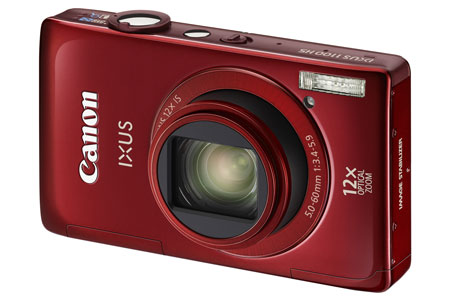 |
Canon ELPH 510 HS / IXUS 1100 HS Design and controls
Measuring 99 x 59 x 22mm and weighing 206 grams including card and battery, the ELPH 510 HS / IXUS 1100 HS is the largest model in the IXUS range, but it’s still very compact and will comfortably fit in your pocket. This year’s ELPH / IXUS models are less rounded than their predecessors, more like a (thin) bar of soap than a choc ice and the ELPH 510 HS / IXUS 1100 HS’ lack of physical controls combined with the satin-finished stainless steel body give it a sleek yet solid look and feel. It’s available in black, silver and red.
The screen measures 3.2 inches diagonally and has a 16:9 aspect ratio which is great for shooting movies, but when shooting 4:3 format stills only the central portion of the screen is used with thick black bars down either side. The space doesn’t go to waste as that’s where the touch icons are placed and, despite the smaller area the screen area , it’s detailed, bright, punchy and visible in all but direct sunlight.
If you’re shooting in a 4:3 stills mode, which is going to be the case if you want to use the full 12 Megapixel sensor resolution, when you press the record touch icon to shoot video the screen switches to 16:9 format using the full screen area with the stop icon superimposed. This makes it difficult to frame a shot before recording video. You can get around this by switching to a 16:9 stills mode, but if you want to shoot full resolution 4:3 and record to video with a single touch, you just have to live with it.
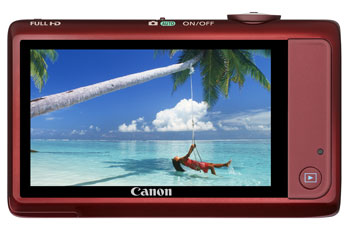 |
|
As I’ve mentioned, the ELPH 510 HS / IXUS 1100 HS is almost entirely lacking in physical controls, but it does have a two-position mode switch for switching between Smart Auto and the most recently selected option on the exposure mode menu. It also has a playback button which could easily have been a touch icon but then you wouldn’t be able to switch the camera on in playback mode which is handy if you just want to review photos without extending the lens.
The ELPH 510 HS / IXUS 1100 HS has a built-in flash with a maximum range of 3.1 Metres. The flash unit is mounted on the left corner of the front panel and on all the latest IXUS models you need to take care not to cover it with your left index finger. You can force the flash on or turn it off, in Auto it fires when needed and there’s also a slow sync mode so you can provide fill in illumination while making the most of the ambient lighting. Smart Flash Exposure automatically adjusts flash output for best results and you can lock the flash exposure by touching the screen while pointing the camera at your subject, ensuring that the flash exposure remains the same for subsequent shots. The ELPH 510 HS / IXUS 1100 HS has two defences against red-eye; the first employs the AF lamp as a pre-flash and there’s also a firmware correction which can be applied at the time of shooting or subsequently. Canon has launched a new external flash unit, the HF-DC2 attaches to the camera via a bracket that screws into the tripod bush and can be used with all models in the ELPH / IXUS range.
The ELPH 510 HS / IXUS 1100 HS has an unusual arrangement with separate compartments for the NB-9L Lithium Ion battery and the memory card. One advantage of this is that you can change cards while the camera is mounted on a tripod. It’s compatible with SD, SDXC and SDHC cards. The ELPH 510 HS / IXUS 1100 HS’ output ports are located under a cover on the top of the right side. There’s a combined USB / AV port and a mini HDMI port, but no cables are supplied so you’ll need to buy an HDMI cable or the optional AVC-DC400ST cable if you want to connect the camera directly to your TV to view photos and movies.
Canon ELPH 510 HS / IXUS 1100 HS lens and stabilisation
The ELPH 510 HS / IXUS 1100 HS has a 12x stabilised optical zoom with an equivalent range of 28 – 336mm. That’s a pretty impressive zoom range for a camera that’s 22mm thin, in fact, according to Canon, the ELPH 510 HS / IXUS 1100 HS is the world’s slimmest 12x compact zoom. The 28mm wide angle is perfect for interiors, group shots and landscapes and the telephoto gets you in close enough for most distant subjects. It lacks the 24mm super-wide angle view of the ELPH 300 HS / IXUS 220 HS and, if you like to shoot say, wildlife or surfing, it won’t get you in as close as a something like the PowerShot SX40, but in this compact a format, there’s very little that provides a similar range – for example the Sony Cybershot HX9V and Panasonic Lumix ZS10 / TZ20 may both have 16x zooms but are also both a third thicker.
The ELPH 510 HS / IXUS 1100 HS features Canon’s new Intelligent IS stabilisation system which automatically selects the best stabilisation mode for the conditions. It can tell when you’re panning in portrait or landscape orientation, when you’re taking close-up macro shots and when the camera is on a tripod and sets the appropriate stabilizer mode or, in the last case disables it.
ELPH 510 HS / IXUS 1100 HS coverage wide |
ELPH 510 HS / IXUS 1100 HS coverage tele | |
 | 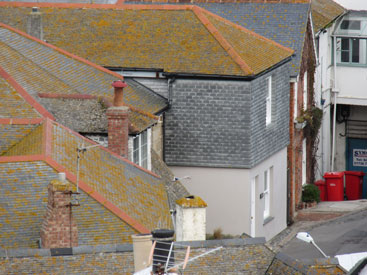 | |
| 5-60 mm at 5mm (28mm equivalent) | 5-60mm at 60mm (336mm equivalent) |
To test the stabilisation on the ELPH 510 HS / IXUS 1100 HS I took a series of hand-held shots at different shutter speeds with the lens set to its maximum zoom setting of 336mm (equivalent), both with IS set to Continuous and turned off. The crops below are from shots taken at 1/20 with the IS turned off (left) and on Continuous (right). As you can see, the ELPH 510 HS / IXUS 1100 HS is capable of an impressive 4 stops of stabilisation.
ELPH 510 HS / IXUS 1100 HS IS Off/On (Continuous) | ||||
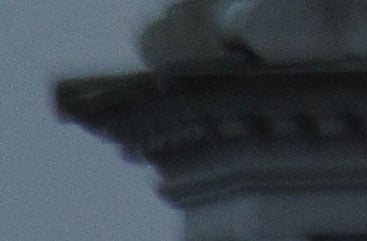 | 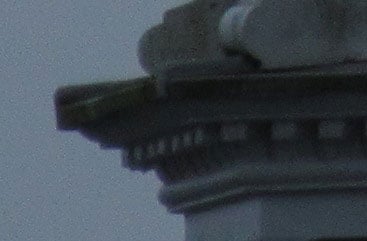 | |||
100% crop, 5-60mm at 60mm, 200 ISO 1/20, IS off. |
100% crop, 5-60mm at 60mm, 200 ISO 1/20, IS on. | |||
Canon ELPH 510 HS / IXUS 1100 HS shooting modes
With the mode switch set to Smart Auto the ELPH 510 HS / IXUS 1100 HS uses scene detection to determine the optimum exposure. The Digic 4 processor’s approach to scene detection is a sophisticated one, first determining whether there are people in the frame and if they are moving, then what the lighting conditions are and finally whether the camera is mounted on a tripod. It’s quick and almost always accurate.
|
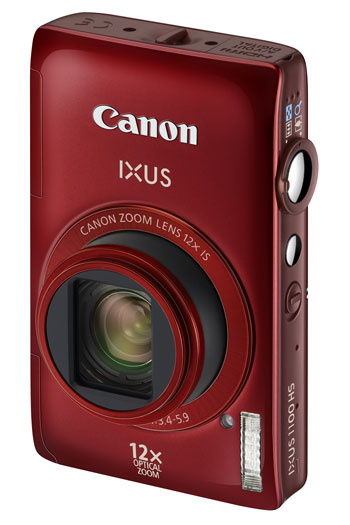 |
Program mode provides control over ISO sensitivity, white balance, colour rendering and some other settings but beyond exposure compensation there’s no semi-automatic or manual control over exposure settings. There are plenty of scene modes though and, as on other recent ELPH / IXUS models, Canon has added Creative Effects to the exposure mode menu rather than assign a separate menu to them. This means there are no fewer than 24 of them, but at least on the ELPH 510 HS / IXUS 1100 HS’ touch menu they are paged and the touch screen makes it much easier to scroll through and quickly find the one you want.
The Creative filter effects include Monochrome, Toy Camera, Fish-eye, Super Vivid, Poster Effect, Colour Accent, Colour Swap and Miniature. The ELPH 510 HS / IXUS 1100 HS has a Handheld Night Scene mode which takes three shots in quick succession and composites them to produce a single image. Best Image Selection mode takes five shots in rapid succession and chooses the best one, which generally means the one with least camera shake and subject blur, and saves it to the card. It’s useful in situations where the light means you can’t be confident of getting a good shot, but the fact that it’s limited to 3M resolution is somewhat disappointing.
The Smart Shutter scene mode is included which can fire the shutter up to 10 times when a smile is detected, and includes Face and Wink self-timer functions so that you can include yourself in a group photo without dashing around like a lunatic. There’s also Canon’s innovative movie digest mode which saves a buffered movie clip of the action a few seconds prior to each still shot and combines them all into single movie.
Canon ELPH 510 HS / IXUS 1100 HS movie modes
The ELPH 510 HS / IXUS 1100 HS’ best quality movie mode is 1080p24 which will make it a popular choice with movie makers who prefer the film-like quality of video shot at 24 frames per second. There are also 720p and standard resolution 640 x 480 modes at 30fps. The maximum recording time in 1080p mode is 10 minutes or when the file size reaches 4GB. You’ll need a Class 6 card or faster.
Movies can be shot in Program auto exposure mode or Smart Auto mode which takes advantage of scene detection to determine the correct exposure. There’s no manual control over exposure and you can’t use exposure compensation either; you can set it, but when you press the record button it’s ignored, which is a little surprising as this works on the non-touch screen ELPH / IXUS models.
You can also shoot video using some of the Creative filter effects including Miniature mode. By default, Miniature mode movies are shot in standard definition 640 x 480 format. If you want to shoot in 720p mode you have to change the still photo aspect ratio to 16:9. This is an odd way of doing things; we’d expect that the best quality mode to be the default and it would make more sense for the movie mode settings to follow whatever was set for ‘normal’ shooting, rather than tucked away in the still image formats.
One of the advantages that Canon’s Miniature mode has over other variants is that you can select the focus zone area. This is done by moving a rectangular frame up and down the screen and can be set in both horizontal and vertical planes either for portrait shots or where the subject just works better with the blurred regions to the left and right of the focus zone, rather than top and bottom.
Finally, the ELPH 510 HS / IXUS 1100 HS also has Super Slow Motion movie mode which shoots 640×480 clips at 120fps and 320×240 clips at 240fps. When played back at 30fps these are slowed-down by a factor of 4x and 8x respectively.
Movie shooting employs Dynamic IS which provides extra stabilisation to iron out wobbles caused, for example by walking and shooting a the same time. There’s also a Powered IS mode which works in addition to Dynamic IS to provide extra stability at the telephoto end of the zoom range. This works very effectively as you can see in the clip below.
| |
|---|---|
|
Even at 336mm, Canon’s new Powered IS is able to iron out most (though not all) wobbles, as this hand-held panning shot demonstrates. The zoom motor noise is quite intrusive here.
| |
|---|---|
|
Good auto exposure and focus on this tripod mounted shot, and the zoom motor is less audible than on the hand-held panning shot above, though you can still hear it.
| |
|---|---|
|
Good exposure control from the ELPH 510 HS / IXUS 1100 HS indoors, but the white balance is a little inconsistent. Audio quality is good, but you need to take care not to obstruct the top-panel-mounted stereo mics with your finger.
| |
|---|---|
|
Like all the current IXUS models, the ELPH 510 HS / IXUS 1100 HS can shoot in miniature mode at 720p resolution. This is one minute of shooting at the 20x setting, giving a 3 second clip.
Canon ELPH 510 HS / IXUS 1100 HS
handling
The ELPH 510 HS / IXUS 1100 HS takes three seconds to start up when you press the on/off button, so speed out of the blocks isn’t its strong suit. The zoom rocker has two speed positions (except when recording video) which means it can cover the range swiftly while also providing a good level of control. There are two focus modes. Face detect defaults to nine-area AF when there are no faces in the frame or you can select fixed frame. In this mode a centre frame is the default but you can touch the screen to move the focus area anywhere other than the extreme edges of the screen. Touching the screen in Face detect AF mode initiates AF tracking and, as with Face detect, in good light the ELPH 510 HS / IXUS 1100 HS does an excellent job of holding onto the subject. With the touch shutter activated, touching the screen sets the focus and releasing fires the shutter.
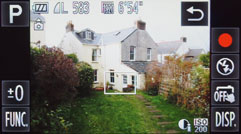 |
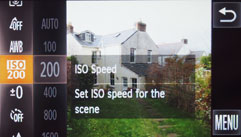 |
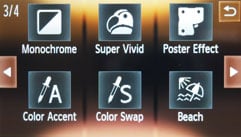 |
All in all, the ELPH 510 HS / IXUS 1100 HS makes good use of the touch-screen both to operate the camera and to make menu selections and change settings. But it isn’t nearly as responsive as other touch-screen IXUS models I’ve used. It requires quite a lot of pressure to activate and on the menus you have to be very precise. Even after using it for a couple of weeks I still frequently found myself having to press a menu selection more than once before it would respond. I’d strongly recommend you try the ELPH 510 HS / IXUS 1100 HS first if you’re considering buying one.
In continuous shooting mode the ELPH 510 HS / IXUS 1100 HS fell a little short of the published speeds with a best full resolution continuous shooting rate of 2.5 frames per second and a reduced 3M resolution High-speed Burst mode rate of 6.6 fps. While better than non-HS canon compacts, with Sony offering 10fps full resolution burst shooting on its high end CMOS-based Cyber-shot compacts, this is an area in which Canon needs to do some catching up.
The ELPH 510 HS / IXUS 1100 HS has a 12.1 Megapixel back-illuminated CMOS sensor which produces 4:3 still images with a maximum size of 4000 x 3000 pixels and has two JPEG compression quality settings. On the best quality fine setting image file size around 3MB. The ISO range is 100 to 3200 ISO and the shutter speed range is 15 seconds to 1/4000.
To see how the quality of the ELPH 510 HS / IXUS 1100 HS measures-up in practice, take a look at our real-life resolution and high ISO noise results pages, browse the sample images gallery, or skip to the chase and head straight for our verdict.





